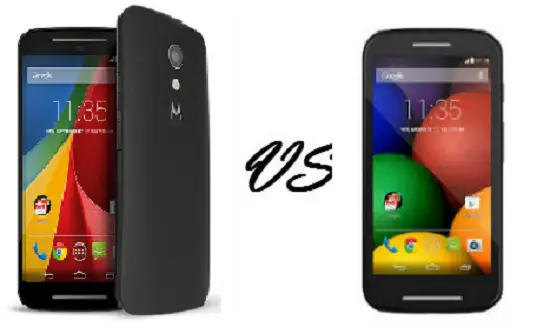Display and Processor
The new Moto G is given a large 5 inch IPS LCD display that packs in HD resolution housing 1280×720 pixels with a decent pixel density of 294 pixels per inch. Going by comparison, the Moto E flaunts a 4.3 inch display with a qHD resolution of 960×540 pixels resulting in 256 ppi pixel density. Moreover, both the displays are protected using the Corning Gorilla Glass 3 scratch resistant coating. Motorola claims that the handsets will render crisp and sharp content on screen. The new Moto G uses a Qualcomm Snapdragon 400 chipset comprising of a 1.2 GHz quad-core Cortex A7 processor supplemented with Adreno 305 graphics engine and 1 GB of RAM for efficient multi-tasking. On the other hand, Moto E draws power from a 1.2 GHz dual-core Qualcomm Snapdragon 200 chipset paired with Adreno 302 graphics engine and similar 1 GB of RAM. Obviously, the Snapdragon 400 SoC delivers better graphics performance, efficient browsing experience and impressive perormance with four cores.
Camera and Internal Storage
There is an 8 MP primary camera at the back of Moto G successor along with auto focus, LED flash and HDR shooting mode. This is teamed up with a 2 MP front-facing camera that for video conferencing and clicking selfies. In comparison, the Moto E becomes a weak contender with a 5 MP primary snapper that does not feature LED flash and there is no front-facer that makes it an outdated offering. Again, the new Moto G wins in the storage department with 16 GB of internal storage space, whereas the Moto E is still stuck on with 4 GB of memory capacity. However, both the devices come with expandable storage support up to 32 GB via a micro SD card.
Battery and Features
In the battery department there seems to be not much difference as the Moto G sequel is powered by a 2,070 mAh battery and the Moto E features a 1,980 mAh battery. Motorola has also assured both the smartphones to last for a day under moderate usage. While the Moto E runs on Android 4.4 KitKat, the new Moto G comes pre-installed with Android 4.4.4 KitKat that is rich in resources. Moreover, the latter is slated to receive the upcoming Android L update. Connectivity wise, the smartphones are not too different as they are packed with dual SIM functionality 3G, Wi-Fi and Bluetooth 4.0.
Key Specs
Price and Comparison
The new Moto G and Moto E are priced in different brackets at Rs 12,999 and Rs 6,999 respectively. Of course, both are impressive smartphones in the entry-level and mid-range market segments that are good enough in their own segment. In all departments, it is the advanced Moto G sequel that wins with enhanced aspects, but if the consumers’ choice is a low priced smartphone, the Moto E should be a better choice.
